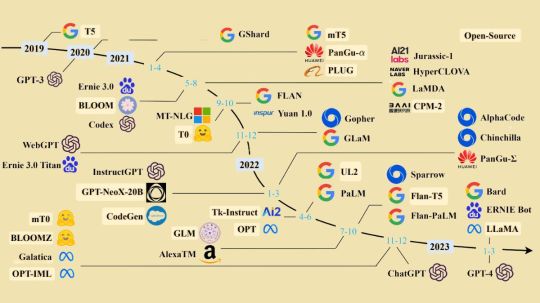#Keyaspectslanguagemodels
Explore tagged Tumblr posts
Text
Mastering Language Models: AI Conversation Building Block

What are language Models?
One kind of machine learning model that has been taught to perform a probability distribution over words is called a language models. In short, a model uses the context of the provided text to forecast the next best word to fill in a blank space in a sentence or phrase.
Since language models enable computers to comprehend, produce, and analyze human language, they are an essential part of natural language processing (NLP). A large text dataset, such a library of books or articles, is mostly used to train them. The next word in a phrase or the creation of fresh, grammatically and semantically coherent material are then predicted by models using the patterns they have learned from this training data.
The Capabilities of language models
Have you ever noticed how the Microsoft SwiftKey and Google Gboard keyboards have clever capabilities that automatically suggest whole phrases while you’re composing text messages? Among the many applications of language models is this one.
Many NLP activities, including text summarization, machine translation, and voice recognition, require it.
Creation of content: Content creation is one of the domains where language models excel. This involves using the information and terms supplied by people to generate whole texts or portions of them. Press releases, blog entries, product descriptions for online stores, poetry, and guitar tabs are just a few examples of the kind of content that may be found there.
POS (part-of-speech) labeling: World-class POS tagging performance is achieved by extensive use of this model. POS tagging assigns a noun, verb, adjective, or other part of speech to each document word. The models can estimate a word’s POS based on its context and the words that surround it in a phrase since they have been trained on vast volumes of annotated text data.
Addressing questions: It is possible to train language models to comprehend and respond to queries both with and without the provided context. They may respond in a variety of ways, such by selecting from a list of possibilities, paraphrasing the response, or extracting certain words.
Summary of a text: Documents, articles, podcasts, movies, and more may all be automatically condensed into their most essential chunks using language models. Models may be used to either summarize the material without using the original language or to extract the most significant information from the original text.
Examination of sentiment: Because it can capture the tone of voice and semantic orientation of texts, the language modeling technique is a strong choice for sentiment analysis applications.
AI that can converse: Voice-enabled apps that need to translate voice to text and voice versa inevitably include language models. This may respond to inputs with relevant text as part of conversational AI systems.
Translation by machine: Machine translation has been improved by ML-powered language models’ capacity to generalize well to lengthy contexts. It may learn the representations of input and output sequences and provide reliable results rather than translating text word for word.
Finishing the code: The capacity of recent large-scale language models to produce, modify, and explain code has been outstanding. They can only, however, translate instructions into code and verify it for mistakes to finish basic programming jobs.
Key aspects of language models
1. Natural Language Processing (NLP)
Language models use NLP approaches to analyze human language and extract meaningful components from words, phrases, and paragraphs.
2. Training
The models are trained on large datasets of text sources such as books, webpages, papers, and more. Training helps them anticipate the next word in a phrase and write like humans by teaching grammar, context, and word connections.
3. Deep Learning
Most recent language models, such as GPT and BERT, rely on deep learning, particularly transformer topologies, to effectively interpret language patterns. Transformers are effective at addressing long-term text dependencies.
4. Applications
It may be used for different activities, such as:
Text creation: Writing tales, poetry, and essays.
Translation: Language translation.
Natural discussion with chatbots.
Summarization: Shortening lengthy articles.
Answering questions with knowledge.
5. Examples
Famous language models include:
GPT-3 by OpenAI generates human-like writing and powers AI apps.
BERT by Google: Useful for search and sentiment analysis, optimized for linguistic context.
The Text-to-Text Transfer Transformer (T5) treats all NLP issues as text production problems and is used for many purposes.
It can allow robots to read, write, and speak like humans.
The Future of language models
Historically, AI business applications concentrated on predictive activities including forecasting, fraud detection, click-through rates, conversions, and low-skill job automation. These restricted uses took great effort to execute and interpret, and were only practical at large scale. However, massive language models altered this.
Large language models like GPT-3 and generative models like Midjouney and DALL-E are transforming the sector, and AI will likely touch practically every part of business in the next years.
Top language model trends are listed below.
Scale and intricacy: The quantity of data and parameters learned on language models will certainly scale.
Multimodality: Integration of language models with visuals, video, and music is intended to enhance their worldview and allow new applications.
Explaining and showing: With more AI in decision-making, ML models must be explainable and transparent. Researchers are trying to make language models more understandable and explain their predictions.
Conversation: It will be utilized increasingly in chatbots, virtual assistants, and customer service to interpret and react to user inputs more naturally.
Language models are projected to improve and be utilized in more applications across fields.
Read more on govindhtech.com
#MasteringLanguageModels#AIConversation#BuildingBlock#machinelearning#voicetext#DALE#naturallanguageprocessing#NLP#OpenAI#ai#Keyaspectslanguagemodels#deeplearning#languagemodels#Applications#technology#technews#news#govindhtech
0 notes